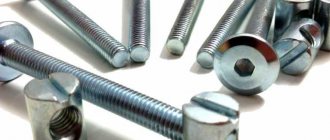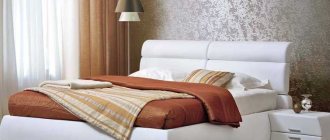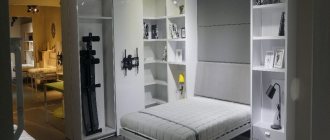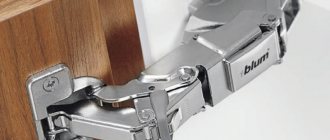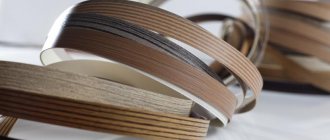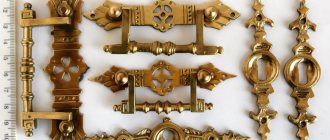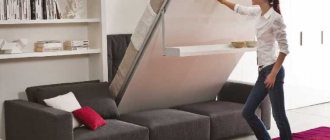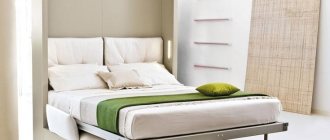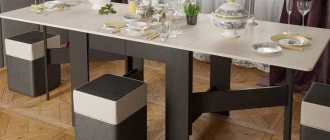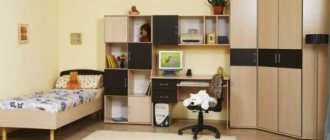The production of any furniture product is not complete without the use of auxiliary accessories, which largely affect the ease of use and service life of the product. Furniture fittings, presented in a variety of varieties, can have different functional purposes - they are responsible for the aesthetic appearance of products, connect elements, act as a lock, and ensure silent opening of doors and drawers. Regardless of the task assigned to specific additional components, they all ensure ease, simplicity, and comfort of use of a kitchen set, wardrobe or sofa.
Basic varieties
All mechanisms and accessories are divided into several varieties. Each of them performs its own function and, accordingly, must meet certain requirements.
Facial
These elements not only carry a functional load, but also remain visible, so the appearance of the furniture largely depends on the front fittings. This type includes the following auxiliary accessories:
- Legs - the stability of the structure and safety of operation depend on them. The supporting furniture element must support the weight of the product and protect the place of contact with the floor covering from it, so as not to scratch or push through the latter. Among the modifications of this fittings are adjustable legs, which allow you to install furniture at the desired height or level it on an uneven floor.
- Wheels or roller supports allow you to easily move furniture. Such fittings are usually used for models that are often moved from place to place (coffee tables, computer chairs), as well as for sliding sofas. This type of headset can be linear or rotary, bushing or bearing. As an additional element, manufacturers provide such products with a stopper.
- Edge - lining the surfaces of the ends of furniture. Edges are distinguished by surface type (with structure, glossy, smooth, others), as well as by the method of fastening (overhead, mortise, rigid).
Wheels
Legs
Edge
Industrial furniture is already equipped with front elements, which makes it possible not to think about purchasing additional materials. When choosing furniture fittings on your own, first of all, preference should be given to reliability and quality. But the styling of the components also plays an important role.
The group of front fittings for detachable furniture includes:
- Handles that open doors, drawers or furniture doors. There are many varieties of this fittings: in the form of a bracket, a button, a ring, a drop. These can also be profiles, roof rails, sinks. Handles are divided into overhead and mortise.
- Locks designed to provide more secure storage of securities and things. They can be mortise, which do not spoil the appearance of the furniture (they are considered more reliable), as well as overhead, attached to the top of doors or drawers. Based on the closing mechanism, push-button, retractable, rotary, and rack-and-pinion varieties can be distinguished.
- Snap hooks are the easiest way to secure a door in a closed position. The loop of the furniture fittings of the hook is fixed on the movable part of the furniture, while the element itself is fixed on the fixed facade.
- Latches, or magnets, are designed to hold doors tightly closed and prevent them from opening spontaneously. They are used as additional or independent door fastening mechanisms. Latches are divided into built-in locks with a magnetic key, models with a bolt that fits into a groove when closed, and magnetic varieties with a locking mechanism.
- Espagnols are also used to secure doors, windows, and gates. According to the principle of operation, they are divided into mechanical (opened and closed manually), as well as automatic, in which when the door slams, the bolt extends, and to open it you subsequently need to press a button.
Characteristics of beech furniture panels, main advantages
Decorative elements can be placed into a separate type of front fittings. They complement the interior with originality and give the entire room a single style coloring, for example, antique. Used to mask joints or design features of furniture. The variety of decorative elements is great. As an example, we can cite an agraph that connects the tops of arches, openings, and niches. As a standard, the element is decorated with carved leaves, branches, and connected at one point in the middle of the top of the arch.
Lock
Magnet
Cap hook
Pens
Espagnolette
Fastening and tightening
The main elements of fastening and fastening fittings for furniture:
- hangers and rails for cabinets - metal plates attached to the wall using self-tapping screws;
- hardware - bolts, screws, screws, nuts, nails, dowels, self-tapping screws;
- body ties - specialized furniture fittings - eccentric or intersectional ties, connecting corners.
The function of fastening and tightening metal fittings for furniture is to facilitate assembly. Ultimately, it becomes invisible on the surface of the products.
Hardware
Screed
Tire
Connective
The function of such fittings is to connect and fix parts with each other. This type of product includes one-piece elements:
- Hinges - designed for closing drawers, cabinets or doors; in turn, they are divided into overhead and semi-overlay, internal and corner, inverse, piano and others.
- Canopy - also allows you to open or close doors; it can be four-hinged, piano, card, mezzanine, secretarial, card.
- Drawer slides provide ease of use with quiet, smooth operation. They are divided into the following types: roller, full extension, reverse action, hidden installation, metaboxes, tandemboxes.
- Mechanisms for flaps - allow the door to smoothly rise up to the fixation point, are divided into mechanical spring fittings and gas lifts.
- Models with closers - used to smoothly open or close cabinet doors; there are gas and oil types of these parts.
Connecting fittings are used in cabinets with doors and drawers.
Canopy
Guides
Loops
Closer
Sliding systems
Sliding systems are used in conventional and built-in wardrobes. This is a special door opening mechanism that ensures softness and quiet use of the headset. Varieties of such systems for furniture assembly: roller, consisting of hidden upper and lower profiles along which the door leaf moves on rollers, and hanging, where the door is suspended from the end of the cabinet.
Hanging
Roller
Shelf holders and fittings for mirrors
A separate type of furniture fittings are shelf holders designed for fixing shelves in cabinets, kitchens or dressing rooms. They are divided into open models, they are mounted to furniture (the shelf is placed directly on them), hidden, resembling an eccentric coupler. Glass fittings such as screws and plugs are used to attach mirrors. They involve drilling holes in the surface, so special rubber seals are additionally required.
Shelf supports
Accessories for mirrors
Cable channels and plugs
A cable channel is a box made of a profile that protects wires from external influences. Plugs mask mounting holes, bolts, nuts, and also prevent the accumulation of dust and dirt in legs and racks made from hollow pipes, and clothes hangers. The elements are supporting, protecting the floor covering from mechanical damage, and also hiding holes. This decorative fittings give the interior and furniture an aesthetic appearance.
Stubs
Cable channel
Hooks and hangers
Hooks, as an independent element of fittings, and components of hangers are designed for storing clothes in a hanging position. This type varies in size and design. Hooks can be mounted on the wall as a separate element or used in cabinet furniture. The most common are one, two and three-arm models.
Types of furniture guides, their installation and selection criteria
Dampers
This type of furniture fittings is used in doors that rise up or open horizontally. The main function is to provide softness when closing. Dampers act as a shock absorber, allowing the door to slam silently. Depending on the operating mechanism, they are divided into hydraulic and pneumatic. Based on the method of fastening to furniture, we can distinguish such varieties as overhead, mortise, self-adhesive, and hinged.
Mechanisms of transformation
This type of fittings is used in the manufacture of convertible folding sofas. Such designs make it easy to change the position of the soft surface, increase the area of the sleeping area, and make the product more functional. Transformable furniture may involve the use of retractable, unfolding systems. In addition to sofas, fittings of this type are also used for folding tables.
Fastening accessories for furniture
These structures are used to connect parts. This group includes the following types of products.
Furniture hinges
Used when installing sashes and doors. They are made of metal and must have a large margin of strength, withstand constant loads, holding the door or flap and ensuring its opening and closing. Loops can have different designs. The angle of opening of the sash, the specific method of fastening, the possibility of independently returning the sash to the closed position, and the possibility of fixing the door in the open position at a certain angle depend on it.
Lifting mechanisms and elevators
They are an alternative to hinges; they are most often used if it is necessary for the sash to open in a vertical plane (recline). Elevators and lifting mechanisms can have different designs, be mechanical and gas. A damping function can also be provided, in which the open sash can be fixed in any position.
Shelf holders
Used for fastening shelves inside custom-made cabinet furniture. They may involve a fixed fastening, as well as fixing with the possibility of folding the shelf.
Ties
This group includes fasteners whose sole purpose is to secure individual parts relative to each other. Bolts, screws, self-tapping screws, angles, etc. can be used as ties.
Accessories for drawers
These are systems of guides and rollers that ensure the movement of boxes in a horizontal plane. As a rule, such systems have travel limiters.
Sealing elements
They are made from different materials, from PVC to silicone. They have two main functions: ensuring tight, reliable joining of parts and protecting their joints from mechanical destruction.
Particularly stringent requirements are imposed on the quality of fastening hardware. It must be reliable and durable, ensuring trouble-free operation of the furniture for many years. Another important nuance is compactness. Such products should not be too large; it is important that they are inconspicuous and do not take up too much space - this will save interior furniture space.
For custom kitchens we use only high-quality, durable and reliable fittings. It is selected taking into account a number of parameters - from the weight and size of individual parts to appearance and functionality. The right choice of such products is the key to ensuring that the furniture will last a long time and its use will be truly comfortable.
Specific fittings for kitchen filling
Kitchen furniture should be easy to use and reliable. Therefore, modern kitchen cabinets are filled with various devices that allow them to be used with maximum efficiency. Specific new furniture fittings for kitchen sets include:
- Pull-out containers, baskets, columns, cargo. They are installed inside cabinets and, using special mechanisms, move out smoothly and silently, which allows you to easily remove bottles, household chemicals and other items stored in them. The fittings come in various configurations (for example, with a rotating mechanism), as well as sizes: one retractable column can have several baskets. Such systems are equipped with rollers, hinges, nets, and guide furniture fittings.
- Mechanisms for corner facades. Such designs are installed in corner cabinets and are also used as roll-out baskets, which allows you to effortlessly get the necessary items. They are divided into retractable and rotating models.
- Railing systems. They are hollow metal tubes that are mounted on the walls above the stove, countertop, and other work surfaces. Designed for hanging kitchen utensils on hooks. The roof rails are equipped with plugs and special corner parts.
- Organizers, drying racks for dishes, shelves for containers, boxes. Designed for storing kitchen utensils. To such fittings you can add drawers for cutlery, storage of spices and others.
- Plinths - accessories for tables, cabinets. They are strips that hide their legs. They give an aesthetic appearance and do not allow dirt and dust to get under the furniture.
The main purpose of kitchen fittings is to save space and rational use of space.
Cargo
Column
Basket
Mechanism for corner facade
Organizers
Railings
Base
Wardrobe systems
Sliding wardrobes are in demand in apartments due to their convenience. Sliding door systems allow you to save space in rooms. They differ in the type of installation. The most popular are:
- Roller profiles are a system of upper and lower profiles that are fastened with self-tapping screws inside the furniture frame. Using rollers, the door leaves move along the profiles to the right/left. The main load in this design falls on the lower profile.
- Hanging - consist of an upper profile to which the door is attached.
Often such mechanisms are equipped with special door locks. By installing furniture fittings with stoppers, the sound of the door hitting the side wall is muffled. Systems for cabinets consist of guides, handles, rollers, strips, seals, and stoppers. In such an innovative sliding door mechanism as coplanar, an additional element of the fittings is the door leaf leveler. It allows the door to move forward when opened, and to return to its place when closed. As a result, the facade of a closed cabinet visually looks like one plane.
Hanging
Roller
Braun
Despite the fact that, based on the name, one might think that this is just another European brand, this is not so. "Brown" is a Ukrainian company, with a central office in Kyiv, founded in 1999. These guys specialize in the production of sliding and hanging aluminum systems. They are also known as a prestigious manufacturer of custom furniture.
The concern is divided into three areas:
- BRAUN fittings and components;
- Mr.Braun sliding wardrobes with profiles of our own production;
- Decor from BRAUN.
Features of components for glass furniture
As for the fittings for glass furniture, they should be characterized by increased moisture resistance and reliability. Such requirements are explained by the fact that sets made of this material are often installed in bathrooms. The main elements of glass furniture components include:
- shelf supports;
- connectors;
- seals;
- supports;
- loops;
- door handles;
- latches;
- closers;
- locks.
Advantages and disadvantages of furniture eccentric screeds
It is necessary to have plastic seals that prevent damage to the glass during use. The surface coating of the screed fittings must also be of high quality, which will reduce the risk of bubbles and peeling.
Materials and design
The main material for the manufacture of furniture fittings is metal (aluminum, steel, metal alloy). It is considered the most reliable and durable. The main disadvantage of such products is their high cost compared to analogues made from other materials. Types of furniture metal fittings:
- Wheels covered with rubber. Reinforced plastic can also be used for their manufacture.
- Pens. For their production, in addition to metal, wood and plastic can be used. An antique model can be made of cast iron.
- Locks are steel or metal alloy.
- Espagnols (sometimes manufacturers use plastic).
- Fastening, clamping, connecting fittings.
- Sliding systems.
Edge fittings can be paper, plastic, or metal. For the production of dampers, rubber and silicone are used - materials that will ensure the longest service life and silent operation. Plugs are plastic products that can also be metal or wood.
Fittings made of plastic are short-lived, they quickly fail and require replacement.
The design of accessories for furniture finishing can be matched to any room design, especially for front elements, which are presented on the market in various style directions. Forged fittings, gilded, with decorative trim correspond to styles such as Gothic, Baroque, and Classicism.
Criterias of choice
Buying kitchen furniture is an important decision. High-quality furniture is expensive and is purchased for many years, so it should be as comfortable, reliable and functional as possible. When choosing, you must take into account the quality of the fittings used. The functionality of the finished headset depends on it. The main criteria for choosing kitchen fittings include:
- Quality of materials. No matter how beautiful and functional the fittings are, if they are made of materials of dubious quality, you should not buy them. Most often, kitchen furniture fittings are made of metal, plastic, wood and glass. It is recommended to give preference to reliable metal. Savings in this case are inappropriate. The cheaper the fittings, the less they will last. It is best to avoid bronze fittings, which are prone to deformation during intensive use.
- Style features. The fittings must fit into the design of the kitchen furniture, so you need to select them in accordance with the style of the space. For a classic kitchen, bronze or gold-plated coating is suitable, for high-tech - chrome elements, for modern - painted parts, as well as Mediterranean style - stone or wood fittings. The best option is to have all the fittings in the same style and color.
- Coating. To protect the fittings from corrosion and damage due to exposure to abrasive detergents, temperature, grease and moisture, a special coating is recommended to extend its service life. The presence of a coating simplifies the maintenance of the fittings.
- Manufacturer. It is best to give preference to reliable European manufacturers, however, many domestic companies guarantee the high quality of their products.
In addition, when choosing fittings for the kitchen, you need to clearly set priorities. For fasteners, first of all, evaluate functionality and strength, and when choosing front fittings, evaluate external qualities.
Selection rules
The reliability of furniture fittings depends on its quality. Therefore, when choosing, this parameter is the first thing you need to pay attention to. This rule especially applies to fasteners. It would be a good idea to make sure that the kit includes installation and installation instructions.
Systems designed for a wardrobe, kitchen mechanism, folding sofa, built-in lock, and other complex structures will work reliably only if they are installed correctly.
The design of the components is also important: they must be in harmony with the overall design style of the room. It is recommended to choose handles and other elements that are always visible in the same color. It is worth considering that the cost of front parts depends not only on their quality, but also on their appearance. Therefore, presentable-looking fittings will not be cheap.
AMIG
The next important player in the furniture fittings market is AMIG. This is a Spanish brand created in 1940. Motto. And the main advantage is that all elements of their products are interchangeable, that is, if some part breaks, there is no need to change the entire mechanism. The company has a huge selection of products, the diversity of which is achieved not only by color and material, but also by interesting external design. The brand has many elements made in an ancient, antique design. Over its many years of experience, the company has made a name for itself and is famous for the quality, reliability and aesthetics of its products.
The best manufacturers
Manufacturers from many countries, including Russia, Italy, and China, manufacture furniture fittings. The leaders of this market segment are presented in the table.
| Manufacturer | Types of products (selected) | Product Features |
| Blum (Austria) | Railings for the kitchen, furniture fasteners, hinges, closers, shock absorbers, drawers, baskets, facade lifts, trays, dividers, dish dryers | The products are distinguished by the highest quality, unique design and aesthetic appearance. |
| Amig (Spain) | Door handles for entrance and interior doors, door hinges, door stops, bolts, latches, components for shutters | Produces high-quality, reliable, unique cast fittings |
| GTV (Poland) | Front and fastening elements, decors, roof rails, drawers, furniture locks, hinges, ties, transformation mechanisms | Offers modern solutions that increase the user value of furniture and the comfort of its daily use |
| Hettich international (Germany) | Hinges, drawer guides, drawer systems, cabinet systems, handles for cabinets and doors, connecting fittings, elements for interior fittings of wardrobes | The products are comfortable, ergonomic, practical, and have a universal design that matches any style. |
The products of these furniture fittings manufacturers are presented in markets all over the world and are in demand by buyers. It is distinguished by reliability, safety, comfort, and smooth opening of the mechanisms.
Bloom
Hettich international
Amig
GTV
